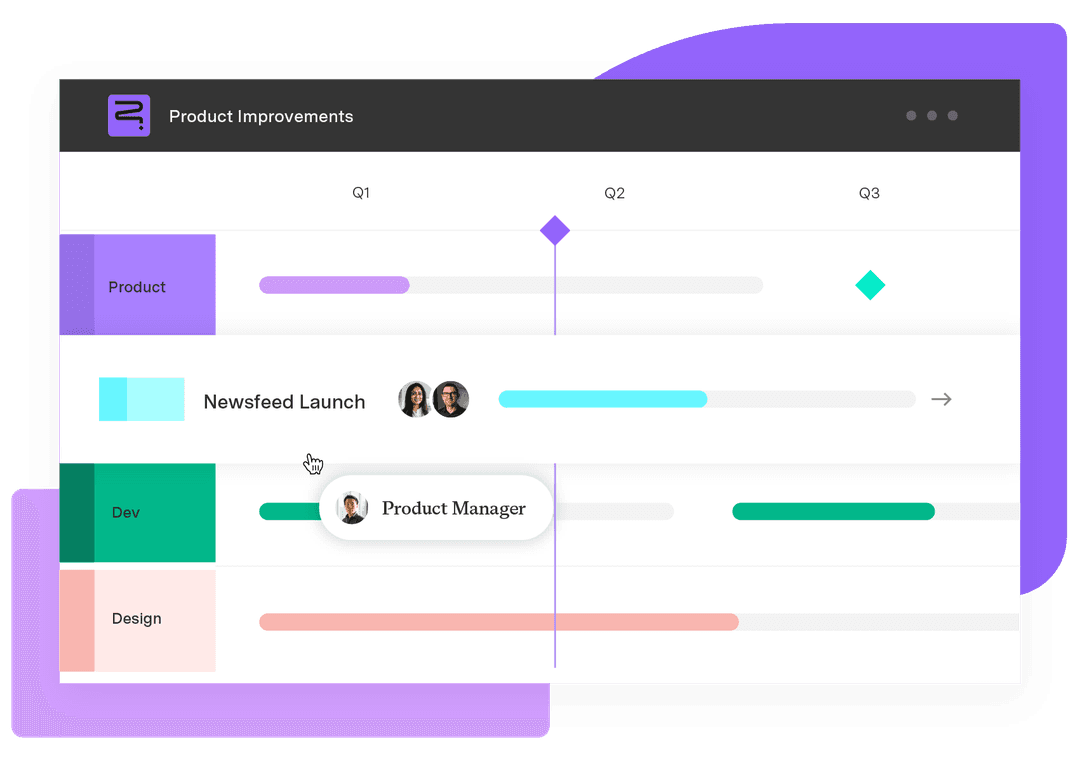30-60-90 template: Plan your first 90 days for success
Tempo Team
The first few months in a new role can feel like a whirlwind. You’re juggling new-to-you responsibilities and figuring out how to mesh with a team, all while trying to make a good first impression.
Onboarding new hires can also be challenging. You’ve got your own responsibilities to manage, but you also need your new team member up to speed as soon as possible.
Whether you’re a fresh hire or a project manager welcoming a team member, having a clear game plan is paramount. A 30-60-90 template offers a structured way to map out those first three months. It helps you prioritize what matters most and move toward meaningful milestones, setting you up for success in the short term and beyond.
What’s a 30-60-90 day plan?
A 30-60-90 day plan is a clear, time-bound framework that helps managers and employees define what to focus on during the first three months of a new position. It breaks onboarding into phases: The first 30 days are usually about learning and observing, the next 30 focus on contributing and improving, and the final 30 are about taking ownership and delivering results.
For all involved, this plan provides a roadmap for progress. It helps managers and employees set goals, define key milestones, and align with stakeholders while making the role’s impact more visible.
Benefits of a 30-60-90 day plan
Without a clear structure, new hires risk losing focus and momentum. Using a structured 30-60-90, or first 90 days template, offers both direction and measurable outcomes. Here's why it works so well.
Easier onboarding for the new teammate
Starting a new job is a challenging process, but a clear 30-60-90 document gives new hires a focused outline of what to learn, who to connect with, and what to accomplish in the first three months, minimizing stress and anxiety.
Clear goals and general alignment
A solid 30-60-90 document aligns personal, team, and organizational goals, ensuring this new hire’s first three months are as productive as possible.
Better performance tracking
Because the 30-60-90 day plan is organized into clear milestones, it’s easier to keep up with progress along the way. Managers can use the plan as a blueprint for success – making sure the new employee is on track at each 30 day interval.
Long-term success planning
Your first 90 days set the tone. When you use a 90-day plan template for new job transitions or team initiatives, you're not only laying a foundation for early wins but also working toward meaningful long-term goals.
How to create a 30-60-90 day plan: 6 steps
Here’s a six-step guide for managers and other team leaders needing to build a 30-60-90 document. We recommend having a general outline put together that you can customize with each new hire, collaborating on this document to make sure the plan works for both of you.
1. Define the bigger picture first
Start with the "why" – what’s your overall purpose for this plan? The most common one is to ramp up a new employee quickly so they can start owning key initiatives, but your “why” might look a bit different depending on the role and your team’s dynamic.
2. Draft a template you’ll actually use
Your organization likely has guidelines for this type of onboarding, but it can be advantageous to tweak the template to match the way you work best. Some people love a written document, while others prefer Notion, Trello, or good old-fashioned Excel. Whatever it is, your 90-day plan should be easy to reference and update.
Break your template down into three clear 30-day blocks and include:
A primary goal for each phase
Key priorities and tasks
Metrics to track progress
Support or resources you’ll need
A spot for notes or weekly check-ins
You can also use digital tools like Jira for project management, Custom Charts templates, or a project dashboard to visualize and track each milestone.
3. Identify the first 30 days: Learn and observe
Think of the first month as a listening tour: Your new employee is learning, asking questions, meeting people, and soaking in the culture.
Their first steps might include:
Meet with colleagues and stakeholders
Understand current workflows, tools, and systems
Review existing documentation and key metrics
4. Identify 60-day targets: Encourage contributions
Your employee should have enough context by their second month to start contributing. Now is a good chance for them to show what they’re capable of.
Focus on:
Helping them build relationships across teams
Offering feedback on current processes
Aligning their work with the team or company strategy
5. Identify 90-day targets: Show your impact
The last phase of your 30-60-90 day plan should highlight the results of your employee’s contributions and outline your plan for their continued success.
Goals might include:
Encouraging them to launch a project
Presenting insights discovered during their onboarding to leadership
Outlining long-term goals or next steps
If you achieve these goals, it shows that you’ve started thinking beyond their initial onboarding process and toward what it means for them to become a long-term asset to the team.
For steps three, four, and five: Make sure you’re setting SMART goals (specific, measurable, achievable, relevant, and time-bound). You want enough specificity so the employee clearly understands what they’re working toward with enough wiggle room to adjust if necessary.
6. Create action items
Now that the goals are clear, convert them into action items. What needs to be done, when, and how?
Each phase should include:
Specific tasks (with due dates)
Success metrics or KPIs
Relevant tools or platforms
Recurring check-ins or progress reviews
30-60-90 day plan example and template
A well-structured 30-60-90 template creates onboarding consistency across departments and makes customizing one for a new hire much easier. Here’s how to create one, and what the finished product might look like.
How to create a 30-60-90 template
Here are the core elements you’ll want in your template:
Start with the job or role expectations: Review the job description, talk with leadership, and outline what new employee success looks like. This gives you the direction you need to tweak your template to each new employee’s needs.
Identify important tools, resources, or people: Whether it’s a project dashboard or access to a tool like Excel for project management, include a detailed list of everything needed for an employee to thrive.
Update as time passes: Don’t let your template collect dust. Check in on it weekly, use it in 1:1s, and update it as priorities shift or your employee hits new milestones.
Set one clear objective for your employee to reach each 30-day phase:
Days 1–30: Learn the company and build relationships
Days 31–60: Start contributing to tasks and projects
Days 61–90: Take ownership and suggest improvements
Break the goal into tasks your employee can take action on:
Week 1: Complete onboarding tasks
Week 2: Meet with key stakeholders
Week 3: Shadow teammates
Week 4: Start taking on small assignments
Choose KPIs that are realistic and measurable:
Completed onboarding tasks
Number of stakeholder meetings
Delivered work (like their first sales plan or project report)
Feedback from their manager or team
Your 30-60-90 day plan template
The example template below outlines the core elements every solid 30-60-90 day plan should include.
Phase | Objective | Key activities/tasks | Success metrics or KPIs | Resources/support needed |
Days 1–30 | Get oriented and build foundational knowledge | Review your job description and company materials Meet with team members and key stakeholders Understand company tools, systems, and processes Start outlining early learning goals | Completion of the onboarding checklist Clear understanding of role and expectations Initial feedback from your team | Onboarding materials Access to internal tools and docs Support from a manager or mentor |
Days 31–60 | Start contributing and collaborating | Begin small projects or tasks Schedule regular check-ins Learn about cross-functional teams and how they work Seek feedback and adjust where needed | Demonstrated progress on tasks Active participation in team activities Feedback showing growth | Collaboration tools Guidance from colleagues Space to focus and execute |
Days 61–90 | Drive impact and plan long-term value | Own and deliver a key project Identify opportunities to improve a company process Present ideas to your team or leadership Build a strategy for your next phase | Achieve a measurable outcome Share a clear roadmap or proposal Positive performance feedback | Continued mentorship Strategic conversations Project-specific resources |
Align individual plans with team strategy using Tempo
A well-thought-out 30-60-90 template can help new hires hit the ground running – but to move the needle, it needs to connect with the team’s bigger goals. That’s where Tempo comes in.
With Strategic Roadmaps, you can map out priorities across teams, making sure each person’s plan supports the organization’s strategy. And Timesheets helps you track progress, spot roadblocks early, and keep everyone aligned and accountable.
Tempo helps you turn plans into progress. Start using Tempo’s tools today to align your team and hit your goals with confidence.












































